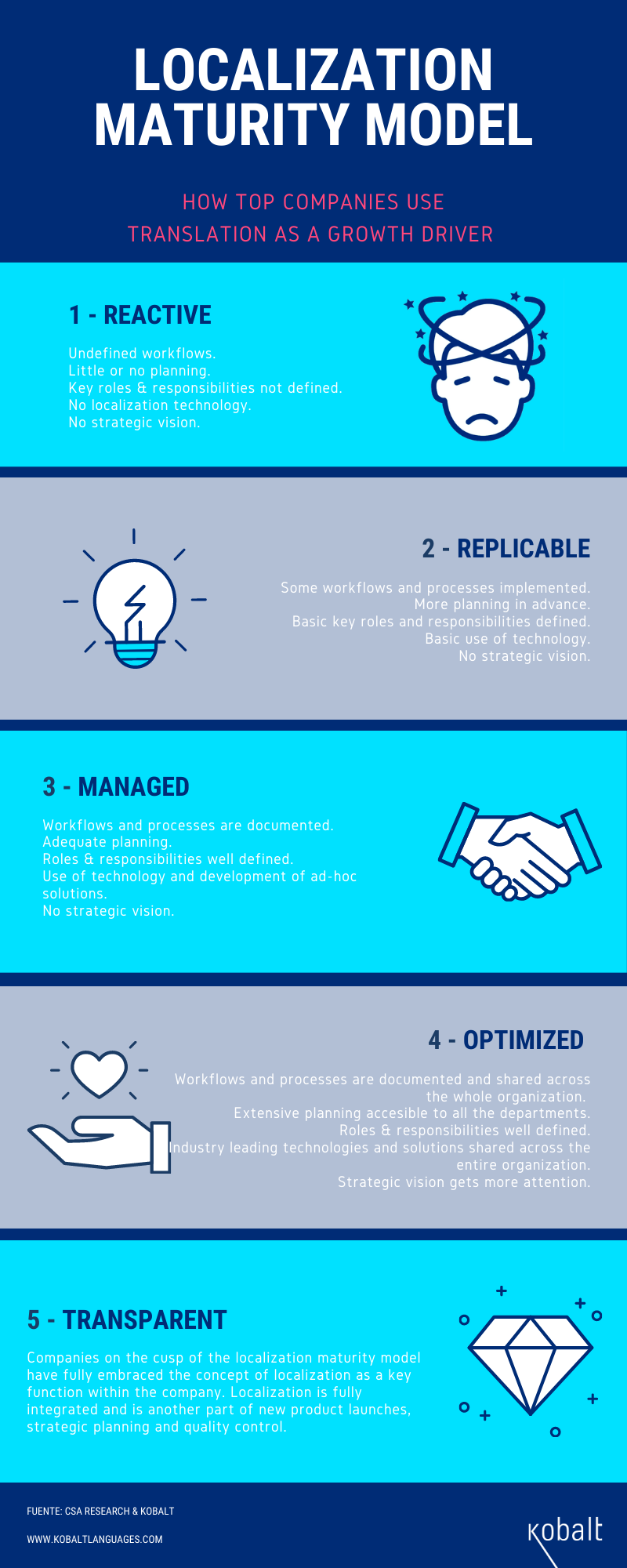More and more companies are launching into the global market with the aim of expanding and achieving greater growth. More markets equal more customers and more growth.
The formula seems simple, but they often run into various obstacles and one of the most significant one is the need to multiply the number of languages ​​in which they operate.
For many of these companies, localization is an enormous task that they launch into without a clear understanding of some concepts and that is usually the cause of many problems. A few years ago, the consulting firm CSA Research presented the Localization Maturity Model to measure the degree of efficiency of organizations in their localization processes.
The most advanced companies offer a better experience to their customers, have accurate data on the effectiveness of localization and make better decisions because of it.
Once we know where we are on this scale, we know what steps we can take to improve this process. The companies that are in the most advanced state (let's think of Apple or Google, for example, although they are not the only ones) are those that offer a better experience to their customers, they have accurate data on the effectiveness of localization, they can make better decisions thanks to this information and they achieve greater efficiency both in their process and the investment itself.
There are five stages in the Localization Maturity Model:
- Reactive
- Replicable
- Managed
- Optimized
- Transparent
Let's have a look at these phases one by one:
1. REACTIVE
At the first stage we have companies which have no strategic reflection regarding the localization and that approach it as a final layer once we have the finished product.
There are no workflows or defined processes and it is improvised ad hoc. These companies usually manage translations internally with staff who are either native speakers or know the language, but who are totally unaware of the processes, tools and methodology in order to create a professional localization flow. These resources are diverted from their primary role in the company to handle the translation, and the results are often mixed.
On the other hand, the specific technology used is non-existent and neither the workflows nor the linguistic resources for subsequent projects are created or documented.
In addition, these companies manage localization as a project with a beginning and an end, which runs parallel to the main functions of the company, and without a person who clearly leads the localization work.
This approach gives greater weight to the original language and relegates the other languages ​​(although in reality they are equivalent to markets) to a secondary role, creating inequalities and focusing more resources on the first market and much fewer resources on other countries. This disparity makes the result in these countries significantly lower. This worse result is often attributed to various causes, when in reality we have not allocated the same resources or established a workflow that allows the different markets to work on equal terms.
Companies in this phase of the maturity model do not see localization as a strategic corporate function and it is often assigned to lower-ranking employees with little decision-making power and influence. The fact that it is not a strategic corporate function means that metrics are not established and the results are not evaluated, so it is impossible to establish the success and profitability of the location.
2. REPLICABLE
In the second step of this maturity model, we find companies that have partly improved their process to facilitate localization and are beginning to plan it to achieve better results. Usually, they outsource the translation to a translation agency that provides the most appropriate technology and methodology for each case.
There are some defined roles that are in charge of supervising the proper functioning of the service and acting as a liaison with external providers and internal clients.
At a strategic level, localization is still not present on the company map and the data derived from this function is not collected or analyzed, so it is difficult to establish the value. In this way, localization is considered a cost center and not an investment.
90% of the companies belong to these first two echelons.
3. MANAGED
In this third phase of the localization maturity model, we find processes and workflows that are established and documented and with well-defined roles.
The planning is usually correct and localization is usually taken into account in the early stages of the project. The investment of time in planning is compensated by a more efficient management of the entire process, with lower costs and a much lower workload.
In this phase, technological tools from external providers are used and, in some cases, other tools are developed to solve any bottlenecks that may arise.
The first basic KPIs begin to be collected and provide a clearer idea of ​​what the ROI of the location can be as well as what we intend to achieve when localizing our service or product.
Localization still does not appear in the company’s general strategy, but it does occupy an increasing portion of the budget and the competencies of some departments.
4. OPTIMIZED
Here we find not only that the processes are documented and well established, but that they are also transversally unified throughout the company, achieving greater synergies between departments and optimizing budgets.
An exhaustive planning is carried out and localization begins to be assumed as a vital core function for the international expansion of the company.
The technology solutions are comprehensive and well developed and available to all departments of the company.
The roles are perfectly defined in all departments.
Localization no longer consists of projects, but is integrated as just another functionality of the different departments. It is not something with a start and end date, rather it is a continuous flow. This makes it possible to search for constant improvements and efficiencies that are introduced in the next cycle to be measured and evaluated.
5. TRANSPARENT
Companies on the cusp of the localization maturity model have fully embraced the concept of localization as a key function within the company. Localization is fully integrated and is another part of new product launches, strategic planning and quality control.
In this last phase, companies have very precise data on the effectiveness of their localization process, the ROI generated by this activity and the advantages of including the localization function as another process and not a project. In this way, they can establish the necessary metrics to measure efficiency, quality and return on investment and initiate a process of continuous improvement of this functionality.

Photo by Jason Strull on Unsplash






